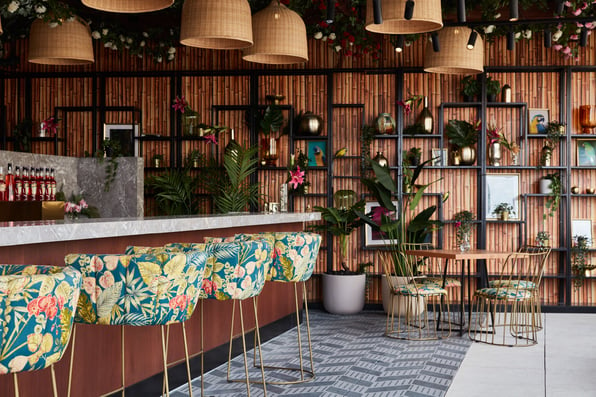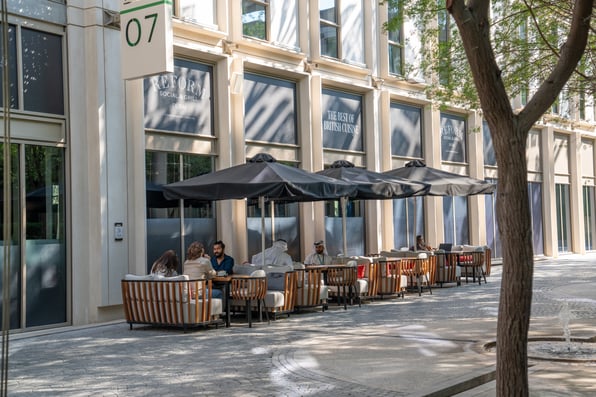Interior design plays a powerful role in how we experience dining—whether it’s the laid-back comfort of a casual spot or the sophistication of fine dining. It’s not just about how a space looks; it’s about how it feels and how it shapes the overall experience. Sharing her insights on balancing functionality with atmosphere, Florentina explores how design can transform dining spaces into memorable experiences that truly resonate.
1. How does interior design influence the overall experience in casual versus fine dining restaurants?

Design serves as a conduit for the energy and atmosphere intended for a space, whether fine dining or casual. An easy-going, casual ambiance is achieved not only by incorporating robustness, practicality, and dynamism in elements such as materials, furniture, and art but also by fostering spontaneous interactions among guests. Intangible principles such as thoughtful space planning, acoustic treatments, and an open interactive design help create an inviting environment where informality feels natural and welcomed.
Design isn’t just decoration—it’s the silent host guiding how guests interact with the space and with each other.
On the other hand, fine dining restaurants are layered with elegance and sophistication, subtly concealing practicality and robustness to make guests feel valued and indulged. Spaces are carefully designed and treated to enhance formality, privacy, and a sense of exclusive curation.
2. What are some design elements that are often overlooked but crucial in distinguishing casual and fine dining spaces?
-2.png?width=3000&height=2000&name=Untitled%20design%20(23)-2.png)
Since these two dining categories are primarily defined by their atmosphere, the sensory elements that shape the experience are often overlooked. Lighting plays an essential role in design; in casual dining, energetic and playful applications—through strategic placement and varied colour temperatures—help create a laid-back ambiance. In contrast, fine dining requires a carefully curated lighting strategy that enhances character, refinement, and a touch of drama.
Similarly, noise levels are pivotal in shaping the dining experience. Casual restaurants often embrace a lively, buzzing atmosphere, encouraging natural chatter, while fine dining spaces prioritise a more serene and intimate acoustic environment. This is achieved through thoughtful ceiling treatments, additional wall or ceiling panelling, and strategic layering of materials, all tailored to the desired ambiance.
3. How do you balance functionality and aesthetics when designing for both dining styles?

Every element in a space should serve a purpose while contributing to the overall narrative and concept of the project. In casual dining, where adaptability is essential for different events and activities, flexibility is key. Modular or movable fixtures that can be easily rearranged are ideal, while a careful balance of eye-catching yet durable materials ensures both aesthetic appeal and functionality.
Fine dining focuses on delivering a highly curated, exclusive experience, emphasising depth in textures and finishes. This requires more tailored spaces with custom-designed furniture.
Seamlessly integrating functional elements, such as service stations, enhances efficiency behind the scenes, ultimately elevating the guest experience.
4. Can you share a key design principle that is effective in both casual and fine dining environments?
.jpg?width=8495&height=5663&name=Steven%20Joyce-JOS2024077D00107%20(1).jpg)
Establishing a strong narrative that informs the concept is a key success factor in restaurant design, whether for a casual setting or a fine dining establishment. A narrative can be as literal as a story told from the perspective of a specific person or as abstract as a defining colour or historical era. The realisation and execution of this narrative are reflected in design details shaped by market and site analysis and tailored to the desired customer experience.
For instance, in one of the large-scale projects I recently worked on, the narrative centred on modernising the region’s established lifestyle and architectural heritage, adapting it to a multi-entertainment venue. In some cases, the narrative is something the end customer directly engages with, while in others—such as this project—it serves as a subtle, underlying theme that fosters a sense of familiarity and belonging.
5. What advice would you give restaurateurs when choosing a design concept for their space?
.jpg?width=8688&height=5792&name=Steven%20Joyce-JOS2024077D00096%20(1).jpg)
I believe restaurants should foster a connection – whether that is between people, food or a place, storytelling through design allows customers to have memorable experiences that leave a lasting impression.
The design should reflect the soul of your brand, where every element feels intentional and true to its identity.
Work with designers who truly listen and understand your vision, and don’t hesitate to embrace bold ideas that make your space unforgettable. Taking risks in design can set a restaurant apart, transforming it from just another dining spot into a destination, drawing customers in and making their experience more immersive. When executed thoughtfully, bold design choices don’t just make a statement; they become an integral part of the restaurant’s identity, ensuring it stands out in a competitive industry.
6. What has been one of the most challenging yet rewarding projects you’ve worked, and if you could design your dream restaurant, what would it look like?

Best Project:
One of my most memorable projects as a lead designer at TGP was designing one of four restaurants within a major hotel group in Saudi Arabia. This concept took guests on a sensory journey through the South Asian subcontinent, drawing inspiration from the rich history of spices in gastronomy.
Visitors are immersed in an olfactory scentscape, surrounded by an elemental space that honours the tradition and ritual of spice, creating a dining experience that’s both captivating and multi-sensory.
Dream Restaurant:
As someone who identifies more as an introvert than an extrovert, I’ve often imagined what a restaurant or café designed specifically for introverts would look like—and I must say, it’s an intriguing challenge. These spaces are typically extroverted by nature, designed for socialising with friends, family, or significant others in a dynamic atmosphere. However, introverts also seek inviting spaces outside their homes where they can enjoy great food without feeling pressured to conform to environments tailored primarily for extroverts. As Susan Cain states in her book Quiet: The Power of Introverts in a World That Can't Stop Talking, people should be able to spend their free time the way they like, not the way they think they’re supposed to.
Introverts tend to prefer less stimulating environments that respect their need for personal space, making this a unique design challenge in the restaurant industry. Some of my initial ideas revolve around enhanced individual adjustability. Beyond flexible seating arrangements catering to solo diners or small, intimate groups, guests could have control over the lighting above their table or access to personal sound systems, allowing them to customise their sensory experience. Additionally, rethinking traditional seating by incorporating varied height levels or unconventional options—such as platforms or nets instead of standard furniture—could create a surreal yet functional design that prioritises privacy and comfort.
As a designer, I find it both amusing and inspiring to tackle challenges like this, where problem-solving extends beyond aesthetics to reimagining how people experience a space.
-1.png?width=3330&height=698&name=TGP%20International%20Logo%20White%20(1)-1.png)



